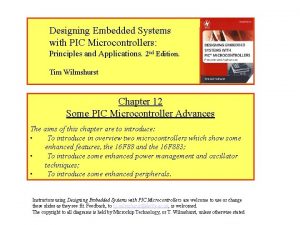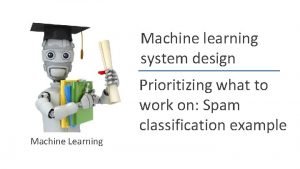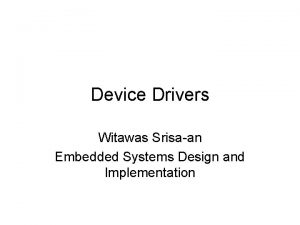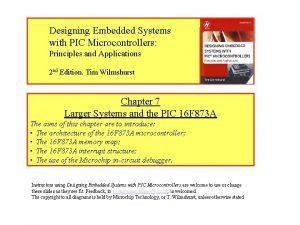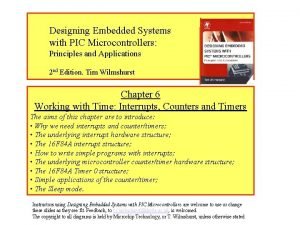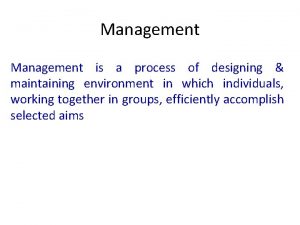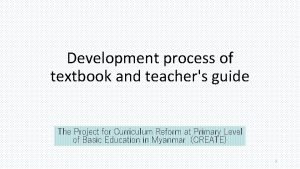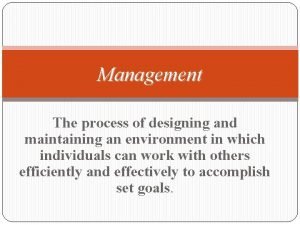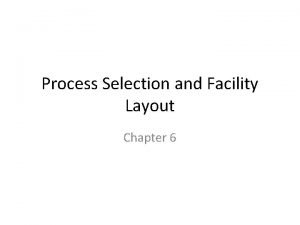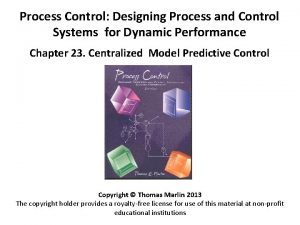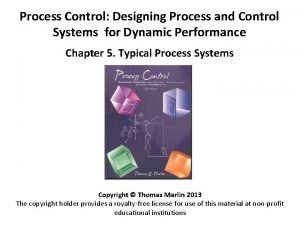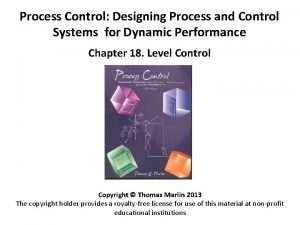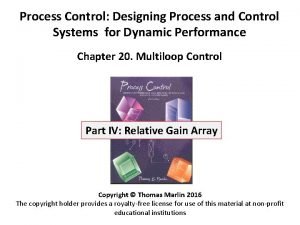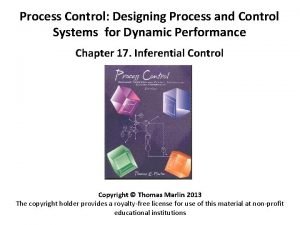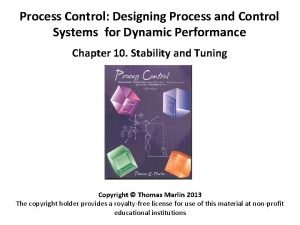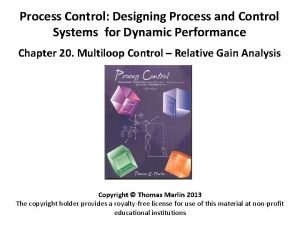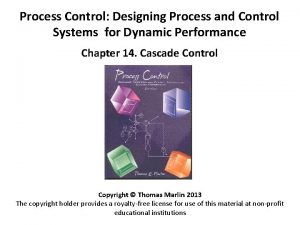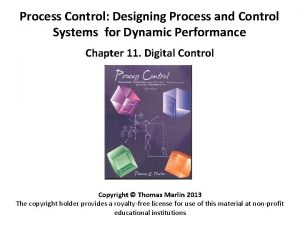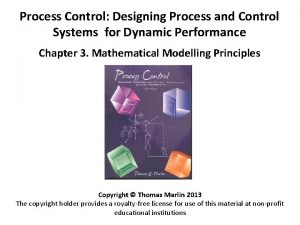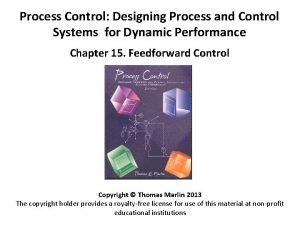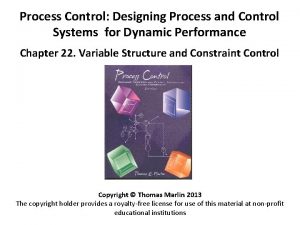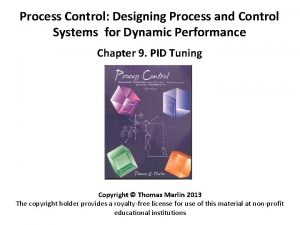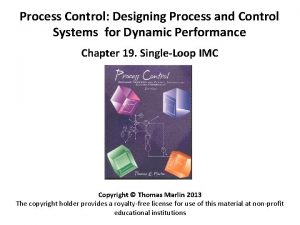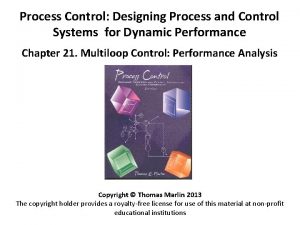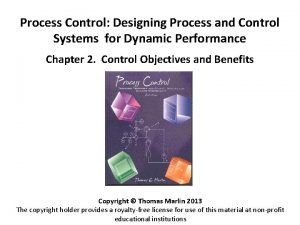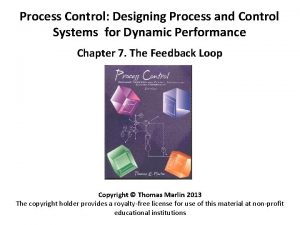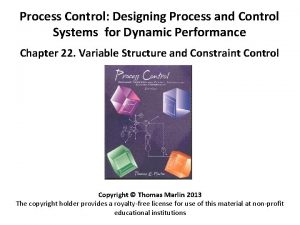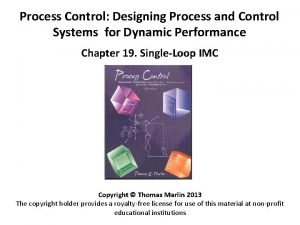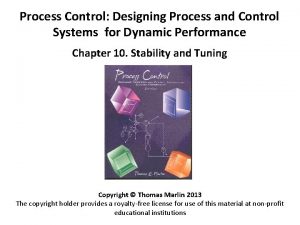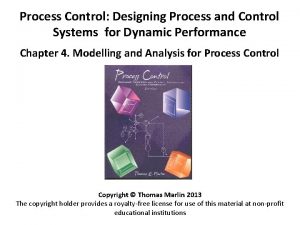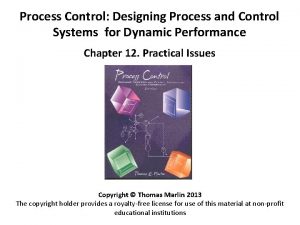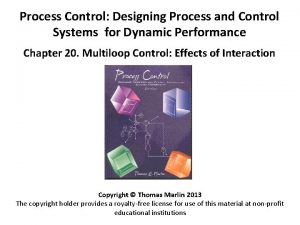Process Control Designing Process and Control Systems for





























- Slides: 29

Process Control: Designing Process and Control Systems for Dynamic Performance Chapter 1. Introduction to Process Control Copyright © Thomas Marlin 2013 The copyright holder provides a royalty-free license for use of this material at non-profit educational institutions

CHAPTER 1 : INTRODUCTION TO PROCESS CONTROL When I complete this chapter, I want to be able to do the following. • Explain the feedback concept applied to control • Explain and identify the three elements in a feedback loop • Be able to apply feedback manually to many chemical process examples

CHAPTER 1 : INTRODUCTION TO PROCESS CONTROL Outline of the lesson. • Why Process Control and Why Now? • Basic Questions about Control - What does a feedback system do? - Why is control necessary? - Why is control possible? - Where is control done? - How is control documented? • Workshop • Self-Study Guides

WHY HAVE A PROCESS CONTROL COURSE? • When I run a kinetics experiment, how do I maintain the temperature and level at desired values? • How do I manufacture products with consistently high quality when raw material properties change? • How much time do I have to respond to a dangerous situation? Every engineer needs basic knowledge about control. Many exciting career opportunities exist for a technical specialist.

WHY NOW FOR THE CONTROL COURSE? • We started with steady-state analysis because it is easier and important. • We are building expertise in fundamentals (fluids, heat transfer, thermo, etc. ) and process units (distillation, CSTR, etc. ). Now we have examples that need control! • We need to master control before integrating our knowledge in process design? It’s a perfect time to learn how to “drive” the chemical process. With this insight, we will be able to design plants that can be controlled safely and produce high quality products.

WHAT DOES A FEEDBACK SYSTEM DO? Let’s look at a few examples first. Then, we will develop a general concept. • Describe your method for driving a car. • Could you drive a car without looking out the windshield? • What must be provided by the car designer? • Can a “good design” eliminate the need to steer?

WHAT DOES A FEEDBACK SYSTEM DO? Let’s look at a few examples first. Then, we will develop a general concept. • Describe how home heating works. • Describe the dynamic behavior of T. • What must be provided by the house designer? • Can a “good design” eliminate the need to change the heating?

WHAT DOES A FEEDBACK SYSTEM DO? Why does the temperature cycle? Is this good enough for all variables in a chemical process? Hint: if “yes”, the course is over!

WHAT DOES A FEEDBACK SYSTEM DO? The control systems appear to have three basic elements. Desired value CONTROLLER FINAL ELEMENT SENSOR PROCESS Inputs Outputs

WHAT DOES A FEEDBACK SYSTEM DO? What is a typical “final element” for chemical processes? What is the meaning of the arrows? How do we select the sensor location?

WHAT DOES A FEEDBACK SYSTEM DO? CONTROL (verb): To maintain desired conditions in a physical system by adjusting selected variables in the system. FEEDBACK CONTROL makes use of an output of a system to influence an input to the same system. input = cause output = effect

WHAT DOES A FEEDBACK SYSTEM DO? Caution: Common misunderstanding in terminology! Common vernacular Engineering & Science Negative feedback: “You are an idiot! Negative feedback: Action to reduce the error from desired. Good! Positive feedback: That was a good idea. Thank you! Positive feedback: Action to increase the error from desired.

WHY IS CONTROL NECESSARY? One word: DISTURBANCES! Give some examples in the CSTR in the figure. v 1 T A CB v 2 We want to achieve the following: 1. Safety 2. Environmental Protect. 3. Equipment protect. 4. Smooth operation 5. Product quality 6. Profit 7. Monitoring and diagnosis Chapter 2

WHY IS CONTROL NECESSARY? x. D FR One word: DISTURBANCES! Give some examples in the distillation tower in the figure. FV x. B

WHY IS CONTROL POSSIBLE? Control is possible only if the engineer provides the required equipment during process design. Part 1: Control equipment Communication Final element v 1 T A Sensors Computing and interface for person CB v 2 Final element

WHY IS CONTROL POSSIBLE? Control is possible only if the engineer provides the required equipment during process design. Part 2: Process equipment v 1 How do we determine the reactor volume? T A CB v 2 How do we determine the heat transfer area?

WHERE IS CONTROL DONE? Sensors, local indicators, and valves in the process Displays of variables, calculations, and commands to valves are in the centralized control center. Shows an older-style control panel

WHERE IS CONTROL DONE? Creative Commons License, see http: //en. wikipedia. org/wiki/File: Nuclear_Ship_Savannah_-_Reactor_Control_Room__Center_and_Left_Panels. jpg

WHERE IS CONTROL DONE? Central control room Sensors, local indicators, and valves in the process Displays of variables, calculations, and commands to valves are in the centralized control center. Shows a modern, computerbased control panel

WHERE IS CONTROL DONE? Photo courtesy of Worsley Alumina and Honeywell

HOW IS CONTROL DESIGN DOCUMENTED? Piping and instrumentation (P&I) drawings provide documentation. • The system is too complex to describe in text. • We must use standard symbols. FC F = flow L = level TC A LC P = pressure T = temperature …. .

CHAPTER 1: INTRODUCTION - WORKSHOP 1 You are implementing control “manually”. Flow Control a. Explain the principle for a typical flow sensor b. Explain how the final element affects the controlled variable. c. Explain the correct action if you want to increase the controlled variable sensor pump valve

CHAPTER 1: INTRODUCTION - WORKSHOP 2 You are implementing control “manually”. a. Explain the principle for a typical liquid level sensor Level Control sensor b. Explain how the final element affects the controlled variable. c. Explain the correct action if you want to increase the controlled variable pump valve

CHAPTER 1: INTRODUCTION - WORKSHOP 3 You are selling a gas to a customer based on the volumetric flow at standard conditions. You decide to use an orifice meter to measure the flow rate. You have learned that the gas flow density may change by -10% from its design (expected) value. What do you do? Orifice meter Our plant Customer compressor valve

CHAPTER 1: INTRODUCTION - WORKSHOP 4 The next page contains a Piping and Instrumentation drawing (P&ID) for a solvent storage tank. First, refer to the following references. • Marlin (200) Appendix A • Sample chapter of Design textbook by Turton et. al. http: //www. pearson. ch/download/media/9780130647924. pdf Answer the following questions. • Determine the flow of fluid in and out of the process • Find examples of measurements displayed locally, in a local control room and a centralized control room. Evaluate these choices. • Identify different types of signal transmission. • Identify different kinds of valves and evaluate the choices. • Identify examples of safety and equipment protection. • Suggest additions to improve this design.

CHAPTER 1: INTRODUCTION - WORKSHOP 4 Source: Tony R. Kuphaldt, CC License, http: //www. openbookproject. net/books/socratic/sinst/output/realistic_diagrams. pdf

CHAPTER 1 : INTRO. TO PROCESS CONTROL How are we doing? • Explain the feedback concept applied to control • Explain and identify the three elements in a feedback loop • Be able to apply feedback manually to many chemical process examples Lot’s of improvement, but we need some more study! • Read the textbook • Review the notes, especially learning goals and workshop • Try out the self-study suggestions • Naturally, we’ll have an assignment!

CHAPTER 1: LEARNING RESOURCES • SITE PC-EDUCATION WEB - Instrumentation Notes - Interactive Learning Module (Chapter 1) www. pc-education. mcmaster. ca - Tutorials (Chapter 1/2) • Textbook Appendix A on drawing symbols - See references for much more detail or symbols - See following general reference book by Tony R. Kuphaldt on instrumentation and control http: //www. openbookproject. net/books/socratic/sinst/

CHAPTER 1: SUGGESTIONS FOR SELF-STUDY 1. Write down the rules (algorithm) that you use when you drive an automobile or bicycle. 2. Formulate questions with answers and trade with members of your study group. 3. Find a P&I drawing in one of the textbook references (or recent volume of Chemical Engineering Progress), explain the strategy, and prepare questions for your instructor on aspects that you do not understand. 4. Find examples of control systems in your house. (Hint: look at the heating, air conditioning, toilet tank, and the most highly automated room, the kitchen. )
 Designing embedded systems with pic microcontrollers
Designing embedded systems with pic microcontrollers Machine learning system design examples
Machine learning system design examples Designing device drivers for embedded systems
Designing device drivers for embedded systems Data memory
Data memory Pic architecture diagram
Pic architecture diagram The process of designing and maintaining an environment
The process of designing and maintaining an environment Textbook development process
Textbook development process The process of designing and maintaining an environment
The process of designing and maintaining an environment The main issue in designing process layouts concerns what?
The main issue in designing process layouts concerns what? Closeness rating examples
Closeness rating examples Process control systems
Process control systems Product and process control
Product and process control Iso 22301 utbildning
Iso 22301 utbildning Novell typiska drag
Novell typiska drag Nationell inriktning för artificiell intelligens
Nationell inriktning för artificiell intelligens Vad står k.r.å.k.a.n för
Vad står k.r.å.k.a.n för Varför kallas perioden 1918-1939 för mellankrigstiden?
Varför kallas perioden 1918-1939 för mellankrigstiden? En lathund för arbete med kontinuitetshantering
En lathund för arbete med kontinuitetshantering Kassaregister ideell förening
Kassaregister ideell förening Tidböcker
Tidböcker Anatomi organ reproduksi
Anatomi organ reproduksi Förklara densitet för barn
Förklara densitet för barn Datorkunskap för nybörjare
Datorkunskap för nybörjare Boverket ka
Boverket ka Att skriva en debattartikel
Att skriva en debattartikel Delegerande ledarstil
Delegerande ledarstil Nyckelkompetenser för livslångt lärande
Nyckelkompetenser för livslångt lärande Påbyggnader för flakfordon
Påbyggnader för flakfordon Formel för lufttryck
Formel för lufttryck Offentlig förvaltning
Offentlig förvaltning
